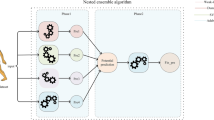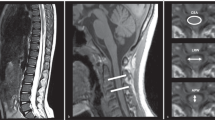Abstract
Study design:
Retrospective, longitudinal analysis of motor recovery data from individuals with cervical (C4–C7) sensorimotor complete spinal cord injury (SCI) according to the International Standards for Neurological Classification of Spinal Cord Injury (ISNCSCI).
Objectives:
To analyze the extent and patterns of spontaneous motor recovery over the first year after traumatic cervical sensorimotor complete SCI.
Methods:
Datasets from the European multicenter study about SCI (EMSCI) and the Sygen randomized clinical trial were examined for conversion of American Spinal Injury Association (ASIA) Impairment Scale (AIS) grade, change in upper extremity motor score (UEMS) or motor level, as well as relationships between these measures.
Results:
There were no overall differences between the EMSCI and Sygen datasets in motor recovery patterns. After 1 year, up to 70% of subjects spontaneously recovered at least one motor level, but only 30% recovered two or more motor levels, with lesser values at intermediate time points. AIS grade conversion did not significantly influence motor level changes. At 1 year, the average spontaneous improvement in bilateral UEMS was 10–11 motor points. There was only moderate relationship between a change in UEMS and a change in cervical motor level (r2=0.30, P<0.05). Regardless of initial cervical motor level, most individuals recover a similar number of motor points or motor levels.
Conclusion:
Careful tracking of cervical motor recovery outcomes may provide the necessary sensitivity and accuracy to reliably detect a subtle, but meaningful treatment effect after sensorimotor complete cervical SCI. The distribution of the UEMS change may be more important functionally than the total UEMS recovered.
Similar content being viewed by others
Log in or create a free account to read this content
Gain free access to this article, as well as selected content from this journal and more on nature.com
or
References
Fawcett JW, Curt A, Steeves JD, Coleman WP, Tuszynski MH, Lammertse D et al. Guidelines for the conduct of clinical trials for spinal cord injury as developed by the ICCP panel: spontaneous recovery after spinal cord injury and statistical power needed for therapeutic clinical trials. Spinal Cord 2007; 45: 190–205.
Steeves JD, Lammertse D, Curt A, Fawcett JW, Tuszynski MH, Ditunno JF et al. Guidelines for the conduct of clinical trials for spinal cord injury (SCI) as developed by the ICCP panel: clinical trial outcome measures. Spinal Cord 2007; 45: 206–221.
Tuszynski MH, Steeves JD, Fawcett JW, Lammertse D, Kalichman M, Rask C et al. Guidelines for the conduct of clinical trials for spinal cord injury as developed by the ICCP panel: clinical trial inclusion/exclusion criteria and ethics. Spinal Cord 2007; 45: 222–231.
Lammertse D, Tuszynski MH, Steeves JD, Curt A, Fawcett JW, Rask C et al. Guidelines for the conduct of clinical trials for spinal cord injury as developed by the ICCP panel: clinical trial design. Spinal Cord 2007; 45: 232–242.
Furlan JC, Fehlings MG, Tator CH, Davis AM . Motor and sensory assessment of patients in clinical trials for pharmacological therapy of acute spinal cord injury: psychometric properties of the ASIA Standards. J Neurotrauma 2008; 25: 1273–1301.
Geisler FH, Coleman WP, Grieco G, Poonian D . The Sygen multicenter acute spinal cord injury study. Spine (Phila Pa 1976) 2001; 26 (24 Suppl): S87–S98.
Geisler FH, Coleman WP, Grieco G, Poonian D . Measurements and recovery patterns in a multicenter study of acute spinal cord injury. Spine (Phila Pa 1976) 2001; 26 (24 Suppl): S68–S86.
Geisler FH, Coleman WP, Grieco G, Poonian D . Recruitment and early treatment in a multicenter study of acute spinal cord injury. Spine (Phila Pa 1976) 2001; 26 (24 Suppl): S58–S67.
Curt A, van Hedel HJ, Klaus D, Dietz V . Recovery from a spinal cord injury: significance of compensation, neural plasticity, and repair. J Neurotrauma 2008; 25: 677–685.
Ditunno Jr JF, Cohen ME, Hauck WW, Jackson AB, Sipski ML . Recovery of upper-extremity strength in complete and incomplete tetraplegia: a multicenter study. Arch Phys Med Rehabil 2000; 81: 389–393.
Mange KC, Ditunno Jr JF, Herbison GJ, Jaweed MM . Recovery of strength at the zone of injury in motor complete and motor incomplete cervical spinal cord injured patients. Arch Phys Med Rehabil 1990; 71: 562–565.
Waters RL, Adkins RH, Yakura JS, Sie I . Motor and sensory recovery following complete tetraplegia. Arch Phys Med Rehabil 1993; 74: 242–247.
Waters RL, Adkins RH, Yakura JS, Sie I . Motor and sensory recovery following incomplete tetraplegia. Arch Phys Med Rehabil 1994; 75: 306–311.
Marino RJ, Ditunno Jr JF, Donovan WH, Maynard Jr F . Neurological recovery after traumatic spinal cord injury: data from the Model Spinal Cord Injury Systems. Arch Phys Med Rehabil 1999; 80: 1391–1396.
American Spinal Injury Association. Reference Manual of the International Standards for Neurological Classification of Spinal Cord Injury. American Spinal Injury Association: Chicago, IL, 2003 (www.asia-spinalinjury.org).
Jakob W, Wirz M, van Hedel HJ, Dietz V . Difficulty of elderly SCI subjects to translate motor recovery—‘body function’—into daily living activities. J Neurotrauma 2009; 26: 2037–2044.
Spiess MR, Muller RM, Rupp R, Schuld C, van Hedel HJ . Conversion in ASIA impairment scale during the first year after traumatic spinal cord injury. J Neurotrauma 2009; 26: 2027–2036.
van Hedel HJ, Curt A . Fighting for each segment: estimating the clinical value of cervical and thoracic segments in SCI. J Neurotrauma 2006; 23: 1621–1631.
van Hedel HJ, EMSCI Study Group. Gait speed in relation to categories of functional ambulation after spinal cord injury. Neurorehabil Neural Repair 2009; 23: 343–350.
van Hedel HJ, Dietz V . Walking during daily life can be validly and responsively assessed in subjects with a spinal cord injury. Neurorehabil Neural Repair 2009; 23: 117–124.
Wirth B, van Hedel HJ, Kometer B, Dietz V, Curt A . Changes in activity after a complete spinal cord injury as measured by the Spinal Cord Independence Measure II (SCIM II). Neurorehabil Neural Repair 2008; 22: 279–287.
Pinheiro JC, Bates DM . Linear Mixed Effects Models. Mixed Effects Models in S and S-Plus. Springer Verlag: New York, 2000.
Savic G, Bergstrom EM, Frankel HL, Jamous MA, Jones PW . Inter-rater reliability of motor and sensory examinations performed according to American Spinal Injury Association standards. Spinal Cord 2007; 45: 444–451.
Burns AS, Lee BS, Ditunno Jr JF, Tessler A . Patient selection for clinical trials: the reliability of the early spinal cord injury examination. J Neurotrauma 2003; 20: 477–482.
Kwon BK, Stammers AM, Belanger LM, Bernardo A, Chan D, Bishop et al. Cerebrospinal fluid inflammatory cytokines and biomarkers of injury severity in acute human spinal cord injury. J Neurotrauma 2010; 27: 669–682.
Blight AR, Tuszynski MH . Clinical trials in spinal cord injury. J Neurotrauma 2006; 23: 586.
Rudhe C, van Hedel HJ . Upper extremity function in persons with tetraplegia: relationships between strength, capacity, and the spinal cord independence measure. Neurorehabil Neural Repair 2009; 23: 413.
Bromley I . Functional Independence. Tetraplegia and Paraplegia: A guide for physiotherapists, 6th edn. Elsevier: Philadelphia, PA, USA, 2006, p 397.
Shao J, Wang H, Chow SC . Large Sample Tests for Proportions. Sample Size Calculations in Clinical Research, Second ed. edited by S. C. Chow Chapman and Hall, Boca Raton, FL, 2008, pp 83–115.
Shao J, Wang H, Chow SC . Comparing Means. Sample Size Calculations in Clinical Research, Second ed. edited by S. C. Chow Chapman and Hall, Boca Raton, FL, 2008, pp 49–81.
Ditunno JF . Outcome measures: evolution in clinical trials of neurological/functional recovery in spinal cord injury. Spinal Cord 2010; 48: 674–684.
Acknowledgements
The support of ICCP (http://www.campaignforcure.org) and SCOPE (http://www.scopesci.org) is gratefully acknowledged. We are grateful for the constructive suggestions of José Zariffa. John Kramer is a doctoral trainee of the Canadian Institute of Health Research and Michael Smith Foundation for Health Research. EMSCI is supported by the International Foundation for Research in Paraplegia, Zürich, Switzerland (IFP, Zurich).
Author information
Authors and Affiliations
Consortia
Corresponding author
Ethics declarations
Competing interests
The authors declare no conflict of interest.
Supplementary information
Rights and permissions
About this article
Cite this article
Steeves, J., Kramer, J., Fawcett, J. et al. Extent of spontaneous motor recovery after traumatic cervical sensorimotor complete spinal cord injury. Spinal Cord 49, 257–265 (2011). https://doi.org/10.1038/sc.2010.99
Received:
Accepted:
Published:
Issue date:
DOI: https://doi.org/10.1038/sc.2010.99
Keywords
This article is cited by
-
Pharmacological management of acute spinal cord injury: a longitudinal multi-cohort observational study
Scientific Reports (2023)
-
Segmental motor recovery after cervical spinal cord injury relates to density and integrity of corticospinal tract projections
Nature Communications (2023)
-
Clinical translation of stem cell therapy for spinal cord injury still premature: results from a single-arm meta-analysis based on 62 clinical trials
BMC Medicine (2022)
-
Spontaneous Motor Recovery after Cervical Spinal Cord Injury: Issues for Nerve Transfer Surgery Decision Making
Spinal Cord (2022)
-
A taxonomy for consistent handling of conditions not related to the spinal cord injury (SCI) in the International Standards for Neurological Classification of SCI (ISNCSCI)
Spinal Cord (2022)



